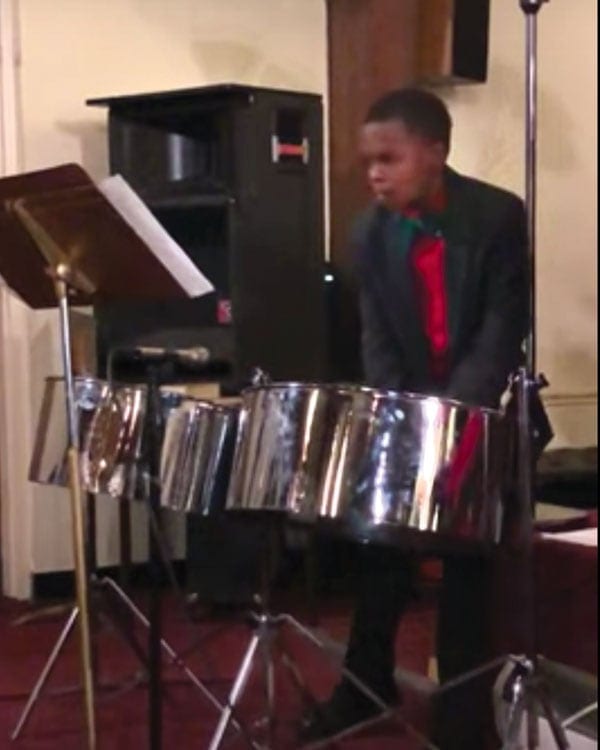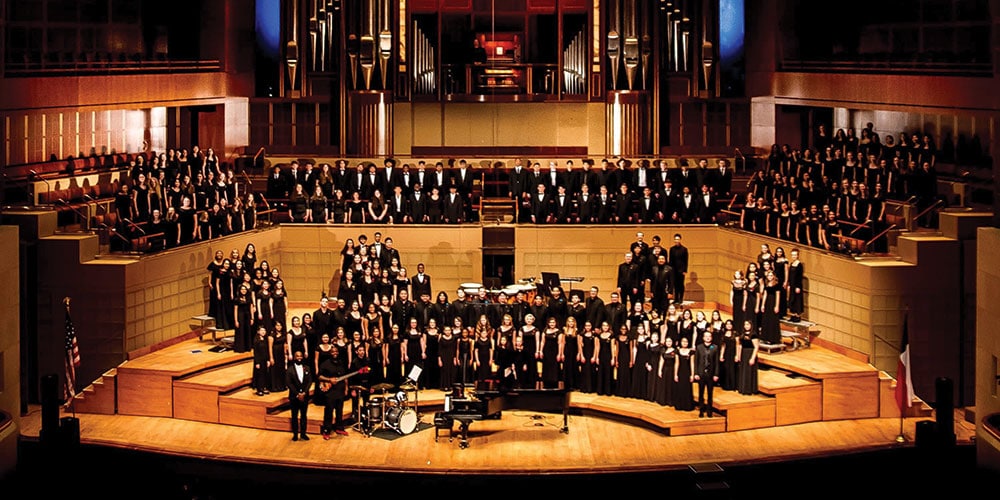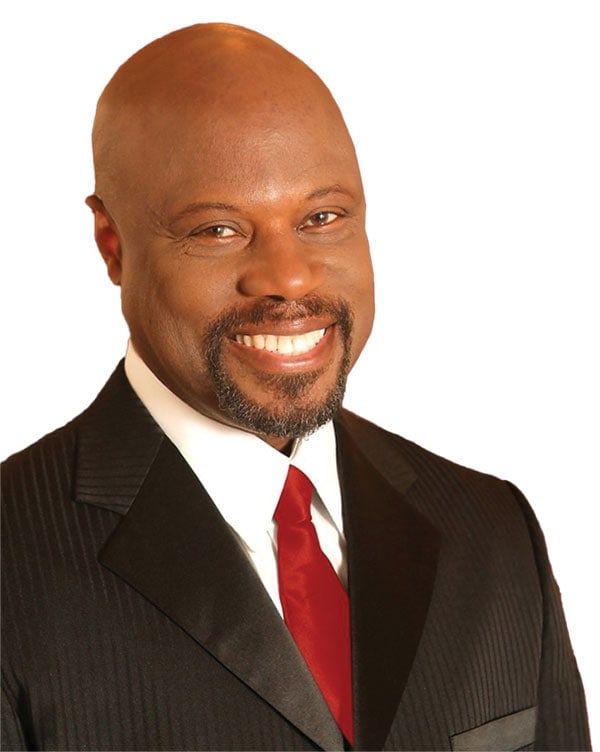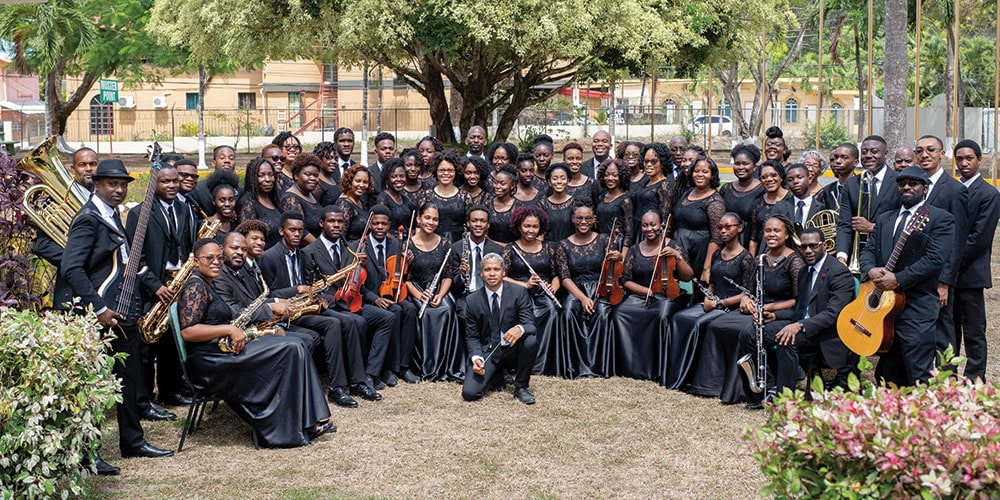
Across the ages and climes of Christmas celebration, one thing, more than any other, holds us all and is held by us in common. So it is whether we live in Caribbean or South Pacific islands; whether across the island continent down under or across grand Asia’s continental time zones; whether we steam in earth’s equatorial forests or freeze in earth’s ice-bound regions; whether ours are giddy dreams of stocking-loads of goodies for the palate and ingenuous new packages of fun, or dreams dashed by poverty’s perplexity and the unique challenge it brings in the holiday season; whether hedonism is the only inspiration or we are numbered among the faithful who worship the Christ as their Savior and Lord.
That one thing is music, from the absurdity of “Jingle Bells” as sung by South American children who have never seen snow or sleigh, through the hypnotizing plainchant that calls, “O Come, O Come, Emmanuel” to Handel’s unconquerable chorus of hallelujahs, music is where Christmas is. Christmas may be many other things, but Christmas is music.
This time around, the music of Christmas that you hear on
Adventist Review television (at special.adventistreview.tv) is reflected in program notes in the pages of your magazine’s December edition.
The concert opens with John Millea’s question, “Who’s This Girl?” You know the answer: she is the mother of the Baby, the Baby whose advent birthed the joy of eternal salvation. Then 12-year-old Alex strums out on steel pans (steel drums) the melody of the holy night of the birth of Messiah, and Heidi invites Emmanuel, a capella, to come. Then follows more music of children reminding us of home, before Anwar reminds us of what it cost the Baby to bring us salvation: it’s the cross, “The Old, Rugged Cross.” Marguerite wonders out loud if Mary knew what she was doing, knew what the implications were, of Christ’s virgin birth.
As Anwar reminds of the cross, so do others remind us of the crown. Conductor Jonathan Wall leads the excitement as the choir of Southwestern Adventist University recognizes God’s agent for declaring the news of the glorious end of all, “John, the Revelator.”
As Wintley sings we think again of the holy night that made everything possible and close our concert with a final reminder, on the wings of music from Kerron Hislop and the choir and orchestra of the University of the Southern Caribbean, that our faith in the Baby and our celebration of joy are not in vain: the day of blissful forever that He promised will come.

Watch and listen noWho’s this girl who looks forth like the morning
Clothed with the sun?
Bright crown of stars adorning
Beauty is undone. . . .
How did the prince become a dragon
Throw God’s stars down with his tail?
She’s been faithful to her one true Lover
Through pain and joy
They gave their hearts to each other
Now she bears His boy
But the dragon, . . .
John’s Revelation 12 vision features a mother giving birth. The name “Christmas” is supposed to be all about that. We see the Madonna-and-child theme everywhere, don’t we? It touches our hearts to know that Jesus entered the human race the way we all do—through a human womb.
What makes both Revelation 12 and the story of the first advent of Jesus unique is the conflict boiling around this simple act of childbearing. It requires much pain and turmoil for the average woman to bear a child—much more so for both Revelation’s woman and the mother of Jesus.
In Revelation 12 the luminescent woman screams in labor pains while a hideous dragon licks his chops, waiting to devour the baby. She gives birth anyway, and flees into the wilderness for 1,260 days.
In the story of the first advent, a glowing young virgin wearily lays herself down in a Bethlehem stable to bear a child, after which the enemy incites King Herod to take that child’s life by murdering all the baby boys in town. Warned by an angel, Joseph and Mary flee to Egypt.
The stories follow the same basic arc—a lovely woman bears a precious baby, then a murderous tyrant drives them into hiding.
There’s another birth the murderous tyrant would love to prevent—the new birth, Jesus born in us today. “Christ in you, the hope of glory” (Col. 1:27) opposes his agenda and inflames his rage. Behind the soft lights, good cheer, and glorious music of Christmas, storms a cosmic conflict intense enough to scare us into hiding. When we receive God’s life-transforming Spirit, experiencing that labor, struggle, and birth of a changed heart, we place Jesus on display before the universe, something His archnemesis hates.
As we struggle through the experience of bearing the image of Jesus in an ungodly world, we receive strength from the witness of the little virgin of Bethlehem who risked her all to answer God’s calling on her life. She witnesses to us of the awesome narrative of the woman, God’s Church, birthing the image of His Son in the sight of a dragon. Courageous Christmas, children of God.
John Millea’s song, “Who’s This Girl?” is part of
Adventist Review’s Christmas concert. You may hear it now at special.adventistreview.tv.
Poem by
John Millea of The Lesser Light Collective, creators of The King Dreams and The Lamb Wins; learn more at www.thelesserlightcollective.com. Writeup by Jennifer Jill Schwirzer, author, counselor, musician.
 LITTLE [STEEL] DRUMMER BOY
LITTLE [STEEL] DRUMMER BOYOne of the great anthems of Christmas is Placide Cappeau’s lyrics, “Cantique de Noël,” (“O Holy Night”). This rigorous translation brings out Cappeau’s message well*:
Midnight, Christians, it is the solemn hour
When God as man descended among us
To expunge the stain of original sin,
And to put an end to the wrath of his Father.
The entire world thrills with hope
On this night which gives us a Savior.
People, on your knees, attend your deliverance.
Christmas! Christmas! Here is the Redeemer!
Christmas! Christmas! Here is the Redeemer!
The ardent light of our faith,
Guides us all to the cradle of the Infant,
As in ancient times a brilliant star
Conducted the Magi there from the Orient.
The King of kings was born in a humble manger;
O mighty ones of today, proud of your grandeur,
It is to your pride that God preaches.
Bow your heads before the Redeemer!
Bow your heads before the Redeemer!
The Redeemer has broken all shackles.
The earth is free and heaven is open.
He sees a brother where there was once but a slave;
Love unites those who restrain the sword.
Who will tell Him our gratitude?
It is for us all that He was born, that He suffered and died.
People, stand up, sing your deliverance!
Christmas! Christmas! Let us sing the Redeemer!
Christmas! Christmas! Let us sing the Redeemer!
In 2007 the William Killebrew Foundation was founded to support victims of abuse and gun violence. As a child Killibrew was raped, saw his mother and sister shot, and saw his grandfather shoot someone over a parking lot dispute. Every Christmas the William Killebrew Foundation invites various musicians to gather for a holiday concert to raise funds for this foundation. In 2019 it invited 12-year-old Alexander Davon Adjahoe to play Adolphe Adam’s melody, “O Holy Night” on steel drums, his double seconds pans. In context of personal experience and the occasion that produced this music, the Christmas hymn’s most significant lines for me, as heard in its modern English translation, are the words “Chains shall He break, for the slave is our brother.”
Adjahoe’s solo, playing an arrangement of Mark Hayes’s “O Holy Night,” is part of the
Adventist Review’s Christmas concert. You may hear it now at special.adventistreview.tv.
*Translated from the French.
Nevilla E. Ottley is founder and principal of the Ottley Music School in Hyattsville, Maryland, United States.
 REJOICE! REJOICE!
REJOICE! REJOICE!Hope is a powerful thing. It can completely change our hearts and minds. To be able to rejoice in the unseen is a power given only by God Himself. Being able to experience reality with all its bumps and bruises is easier when we are protected by hope. We are living in unpredictable times. To equip ourselves with the divine power to rejoice, regardless of our situation, is something attainable. It is possible with Emmanuel, God with us.
Something about this hymn makes me take a breath—it’s tone, it’s choice of musical notes, it’s words of desperation mixed with hope—that gives me pause. This is one of those hymns that is played at the end of a Christmas service under the glow of soft golden lights. We’ve heard it countless times.
But have you listened to the words of this hymn? It has a reverence that is felt immediately. There is no doubt of the emotions expressed from the first line: “O come, O come, Emmanuel.” Can we feel the intensity in the calling? He doesn’t say it once, he says it twice. Please, please, come Emmanuel. He then goes on to explain his emotions about why he needs Emmanuel.
“And ransom captive Israel that mourns in lonely exile here”
Have you ever felt captive? Captive by fear, captive by the unknown, captive by the lack of finances, captive by a broken relationship or captive by loneliness, or maybe even literally captive? We’ve all had moments of captivity. Yet that’s when we need to call on Emmanuel. He says, “Never will I leave you, never will I forsake you” (Deut. 31:6). We can find our hope in Him. Our key is in that next line, “Until the Son of God appears.” The word “until” is key. Without God there is no hope. If you ask God to fill your spirit with hope, that’s when the chains of captivity fall away. When the Son of God appears we can do only one thing: rejoice.
“Rejoice! Rejoice! Emmanuel shall come to thee, O Israel.”
No doubt is expressed in these lines! Read them again. It says “shall come....” That means He hasn’t come yet. The ones singing are rejoicing in the unseen, rejoicing in the fact that they know that Emmanuel will come. Emmanuel will change everything. He will rescue them. He will release them from captivity. He brings hope when there is no hope.
The command to rejoice and the assurance that He will come are unquestionable. The word “shall” shows no doubt. And when we have no doubt, we can’t help but rejoice. So let’s not lose our confidence now. We need to rejoice now more than ever and hope in the unseen. We need to strengthen our faith and sing loudly: “Rejoice! Rejoice! Emmanuel shall come to thee O, Israel.” He is coming soon. Rejoice! Rejoice!
Heidi Mendoza Murphy, a senior art director at JohnsonRauhoff Agency, is a singing Sabbath School teacher and single mom dedicated to God and to her children.

“Softly and Tenderly,” a hymn written by Will L. Thompson in 1880, is probably not a hymn requested during the Christmas season. Perhaps it should be.
“Come home, come home,
Ye who are weary, come home:
Earnestly, tenderly Jesus is calling,
Calling, ‘O sinner, come home!’”
Come home. Christmas at home elicits thoughts of love, family, and acceptance. In these days of strife, tension, and unrest, it is well for us to be reminded of the promise of rest and an eternal home prepared for us by the One who was first laid in a manger.
The Adventist Children’s Choir sings under the direction of Jane Lanning. Lanning founded the choir in 2010 primarily to expose young singers to sacred music, particularly hymns. This elementary choir consists of 95 members in grades 4 through 8, primarily attending Spencerville Adventist Academy, in Silver Spring, Maryland, but it also includes children from the surrounding community. The choir performs regularly for church services, has placed first in several music festivals, and recorded for Hope Channel.
A performance of Thompson’s arrangement by the Adventist Children’s Choir, under the direction of Jane Lanning, is part of the
Adventist Review’s Christmas concert. You may hear it now at special.adventistreview.tv.

When contemporary worship music tends to highlight declarations of praise toward God, celebrating His nature, attributes, and promises, congregations often overlook the opportunity to employ musical content reflective of other perspectives associated with the Christian experience. There are songs that address our spiritual dependence or our yearning for closeness with God. But few in the canon of Adventist hymnody allow room for perspectives on pain, struggle, or humility.
“The Old Rugged Cross,” written in 1912 by George Bennard, a Methodist evangelist, expresses his fascination with the theology surrounding Christ’s humility, His sacrifice on the cross, and the humility His cross-bearing followers must possess. In the chorus of the hymn Bennard penned, “So I’ll cherish the old rugged cross, till my trophies at last I lay down.” The implication is that in order to fully embrace Christ’s sacrifice on the cross, we must first lay aside the things in our lives that we have allowed to determine our worth. Jesus makes this clear when He said that “whoever wants to be my disciple must deny themselves and take up their cross daily and follow me” (Luke 9:23). Cross bearing is an unavoidable feature of the Christian journey, and always involves humility.
This is perhaps why the hymn experienced immediate success shortly following its publication in 1913. When it was written, evangelical revivals were sweeping across the United States, and this gospel song struck a chord with congregations everywhere. The song was part of a shifting trend in worship music, whose lyrical content focused on the Christian experience, portraying God as a personable deity—one who walks with us and knows our struggles.
Here is the paradox of the Christian experience: in following Christ, we must humble ourselves and embrace seasons of hardship along the way while also delighting in His love. Bennard’s hymn reflects this tug-of-war, or healthy tension. In the first stanza he labels the cross an “emblem of suffering and shame,” yet the singer loves “that old cross.” The cross is “despised by the world,” yet it “has a wondrous attraction for me.” We cannot have one without the other.
Not long ago, using the benefits of technology and multilayered recording tools, I “performed” my father’s eight-part male vocal arrangement of “The Old Rugged Cross” for a COVID-19-imposed virtual Communion service at Takoma Park Seventh-day Adventist Church. The arrangement was posted on social media the next day. Within 24 hours it had more than 20,000 views. Days later the count surpassed 40,000.
As I searched for some explanation of its short-term success, it seemed to me that songs like this provide perspective and resolution of faith when so much is uncertain in our country and society. When all is stripped away—the bells, whistles, and ornate presentations of worship our culture embraces—we are left with the bare essentials of what can bring us through life’s hardest struggles.
Fortunately, Jesus is with us during those moments, and promises to remain with us through the process. We may bear the cross of injustice, classism, sickness, suffering, and more, but as Bennard writes, we look forward to the day we will exchange our crosses for eternal crowns.
You may hear Anwar’s eight-part harmony now, part of
Adventist Review’s Christmas concert, at special.adventistreview.tv.
A link to the recording can be found here: www.youtube.com/watch?v=WRAS8hOsb0s.
Anwar Ottley is associate pastor of worship at the Takoma Park Seventh-day Adventist Church and an assistant professor of music at Washington Adventist University.
 THINKING OF MARY KNOWING
THINKING OF MARY KNOWINGMost mothers worldwide can identify with the sentiments of the song “Mary, Did You Know?”* I certainly do. Mark Lowry, who finished penning these lyrics in 1991, did an outstanding job of capturing the depth and magnitude of the most extraordinary story of all time—the birth of the Savior of the world. As a mother of two children, each question posed in these lyrics takes me deeper into the heart of what Mary could have been feeling as she watched Jesus live.
“Mary, did you know that your baby boy will one day walk on water?” And “did you know that . . . [He] will save our sons and daughters?” Put yourself in her shoes and imagine that the boy child you labored over from your womb into stable grass would be the One to save humanity. Then visualize how Mary must have felt each time she saw Jesus do something extraordinary, such as turn water into wine. Yes, she knew who He was—the Christ—but that head knowledge didn’t necessarily cancel out the maternal instincts, yearnings, and labors of this loving mother.
“Mary, did you know that your baby boy will give sight to a blind man?” and “calm a storm with His hand?” Living through the heart of a mother, I feel the weight of all sorts of emotions at once. I feel joy at the sight of a beautiful and healthy baby boy cuddled in my arms. Only a parent can know that type of joy. I feel wonder and awe that I am now responsible for another human life, let alone the world’s Savior.
I tremble as I listen to my child—not yet a teenager—tell me that He “had to be in [His] Father’s house.” All I think is “The only place You need to be is in Your mother’s house!”
Agony overtakes me when I think of how Mary’s Son was nailed to two pieces of wood and dangled on a hill for all to see. Sorrow permeates me as I see Jesus miraculously restore life, then be viciously rejected by His very own for not being the miracle they hoped He would be.
“Mary, did you know that your baby boy has walked where angels trod? When you kissed your little baby, you’ve kissed the face of God.” Wait? What? What do you mean (hand on hip)? My Bahamian culture comes out as I think,
Who? This sweet little innocent child of mine? He’s God? Even though Mary had seen and heard from an angel, I imagine that Jesus’ destiny could not undo the intimate connection that occurs only between mother and child. She was, after all, still human and a doting mother.
Mark Lowry helps us understand just a little bit better the gravity of Mary’s predicament as the mother of God’s Son. Buddy Green brilliantly put this poignant poem to music and brings to life this unequivocal declaration of Jesus’ sovereignty. “This sleeping child you’re holding is the great ‘I Am.’ ”
Marguerite sings Mark Lowry’s poignant lyrics to Buddy Green’s music as part of
Adventist Review’s Christmas concert. Hear her now at special.adventistreview.tv.
* Words and music by Mark Lowry and Buddy Green, © Word Music, Inc.
Link to the music video: drive.google.com/file/d/1x0NFZIpU7eHyTMUZX6gZRuppUhjl0FzL/view?usp=sharing.
Marguerite Samuel, vocal coach and clinician, is artistic director, Women’s Ensemble of Plant City Community Chorale, in Florida, United States.

Every year in Keene, Texas, the music faculty of Southwestern Adventist University hosts a music festival that is the highlight of the academic schedule for musicians and many others. Over the past decade the festival has featured thousands of performers, providing an outlet for choral and instrumental masterworks, while exploring and premiering new music. The past four years the festival has hosted award-winning composers Ēriks Ešenvalds, Kim André Arnesen, Craig Courtney, and Brandon A. Boyd. This distinguished list of composers was commissioned to write music specifically for SWAU’s ensemble, the University Singers, while also assisting in helping the musicians prepare for the premieres. Over the past eight years the University Singers have traveled the globe, taking the gospel in music to 16 countries, sharing love, compassion, and inspiration through passionate and finessed performance.
Among the classics they have performed is a spirited, traditional call-and-response song, “John the Revelator.” The singers sustain an arresting dialogue as “Who’s that writin’?” is answered with “John, the revelator.” As they question and answer we may ourselves reflect on what we have read of the revelator’s writin’: of the land and time where God will dry all our tears, “and there shall be no more death, neither sorrow, nor crying, neither shall there be any more pain” (Rev. 21:4, KJV). That’ll be the day!
A performance of “John, the Revelator,” by the Southwestern Adventist University Choir under the direction of Jonathan Wall, is part of the
Adventist Review’sChristmas concert. You may hear it now at special.adventistreview.tv.
Jonathan Wall is associate professor of Music and director of choral
and vocal studies at Southwestern Adventist University, Keene, Texas, United States.
 O HOLY NIGHT
O HOLY NIGHTIt has been my humble privilege to sing the Christmas hymn “O Holy Night” in many venues around the world. None more memorable than the morning I sang that song in a prison in Slovenia. It was the first time the prison authorities had allowed families of the prisoners to join them inside the prison for a Christmas concert. Seeing children and wives holding their dads and husbands at Christmas in that prison was a moving experience for me.
This song inspires within me a holy optimism, an adoring faith.
It reminds me that Christmas is about a tiny Prince, arriving on the wings of prophecy, carrying in His heart a transformative vision, to redeem and restore the likeness of God in humanity.
This song reminds me that He came from outside our earthly realm, entered our reality, and conquered death with the kiss of love.
That holy night, in that small town of Bethlehem, angels were heard on high, singing, praising, and glorifying God.
A young Mary gave birth to humanity’s greatest miracle, the Supreme Monarch of the universe, veiled in the form of a child.
His name, chosen by right of paternal prerogative, still fills the earth with beauty and the air with song.
This song reminds me that the first time, He came veiled in the form of a child.
The next time He comes in majesty, magnificence, and splendor.
The first time a star marked His arrival.
The next time every star, in reverence, will fall out of its place.
The first time Wise Men and shepherds brought Him gifts.
The next time He comes with His rewards, crowns and diadems, garlands and scepters.
The first time there was no room for Him in the inn.
The next time the cosmos will be unable to contain His glory.
The first time only a few attended His arrival.
The next time every eye shall see Him and every knee shall bow, and tongue confess His Lordship.
How fitting that the final chorus ends on a soaring, triumphant note of sovereignty.
“Christ is the Lord, Oh, praise His name forever!
His power and glory evermore proclaim!”
Wintley Phipps’s solo, “O Holy Night,” is part of the
Adventist Review’s Christmas concert. You may hear it now at special.adventistreview.tv.
Wintley Phipps, pastor, founder of the U.S. Dream Academy and two recording companies, has sung for six United States presidents.

The song performed virtually by our university choir and orchestra is called “A Day Will Come.” This piece encourages us that in these uncertain times, when it seems as if the challenges of each new day are greater than those of the days gone before, it can be difficult to see light at the end of the tunnel.
“A Day Will Come” offers hope that despite the fact that it may seem as if we are “seeing through a glass darkly,” one day the hope of our faith will be realized and everything will make sense when all is revealed at the end of time. We hope that this song is as much of a blessing to you as it is to us. We pray that your spirits will be uplifted by its inspiring message.
The performing ensemble, the university choir and orchestra (UCO) of the University of the Southern Caribbean, is our Music Department’s largest ensemble, featuring a blend of voices and instruments. The group was awarded the “Choir of the Year” title in 2019 and 2020 at the Gospel Music Awards of Trinidad and Tobago (GMATT).
USC mUSiC is delighted to have an opportunity to share our music and be a part of this Adventist Review multimedia Christmas special.
The USC Choir, singing “A Day Will Come” under the direction of Kerron Hislop, is part of the
Adventist Review’sChristmas concert. You may hear it now at special.adventistreview.tv
Kerron Hislop is coordinator of the music program at the University of the Southern Caribbean, Maracas, Trinidad and Tobago.